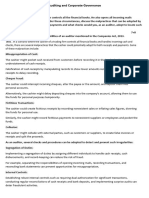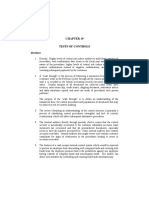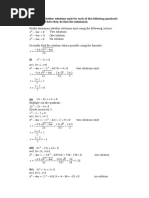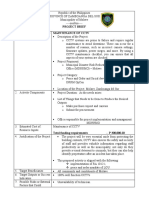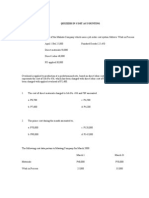0 ratings0% found this document useful (0 votes)
6 viewsAssignment Ind
Mind
Uploaded by
Zelalem TeshomeCopyright
© © All Rights Reserved
Available Formats
Download as DOCX, PDF, TXT or read online on Scribd
0 ratings0% found this document useful (0 votes)
6 viewsAssignment Ind
Mind
Uploaded by
Zelalem TeshomeCopyright
© © All Rights Reserved
Available Formats
Download as DOCX, PDF, TXT or read online on Scribd
You are on page 1/ 3
1.
Internal Control Over Accounts Payable
Internal control over accounts payable is a system of policies and
procedures designed to ensure that an organization’s obligations are
accurately recorded and paid in a timely and authorized manner. Effective
internal controls help prevent errors, fraud, and financial misstatements
while ensuring compliance with laws and regulations. Key components
include:
1. Segregation of Duties: Separate responsibilities for approving invoices,
recording transactions, and making payments to reduce the risk of fraud
or errors.
2. Authorization Procedures: Implement clear approval processes for
purchase orders, invoices, and payment requests. Only authorized
personnel should approve payments.
3. Reconciliation: Regularly reconcile accounts payable records with
vendor statements and general ledger accounts to identify discrepancies
and resolve them promptly.
4. Document Management: Maintain proper documentation, including
purchase orders, invoices, and receipts, to support all transactions and
payments.
5. Vendor Verification: Validate new vendors and review changes to
vendor information to avoid fraudulent or duplicate payments.
6. Timely Recording and Reporting: Ensure that all accounts payable
transactions are recorded promptly and accurately to provide reliable
financial reporting.
7. Monitoring and Auditing: Conduct periodic internal audits and monitor
compliance with accounts payable policies to detect and correct
irregularities.
These controls contribute to financial integrity, operational efficiency, and
risk management within an organization.
2. Audit Program for Accounts Payable and Other Liabilities
An audit program for accounts payable and other liabilities is a structured
plan outlining the procedures auditors will use to evaluate the accuracy,
completeness, and validity of an organization's liabilities. The program
ensures compliance with accounting standards and identifies potential
risks such as misstatements or fraud. Key steps in the audit program
include:
1. Understanding Internal Controls:
Assess the design and implementation of internal controls over accounts
payable and liabilities. This includes reviewing segregation of duties,
authorization processes, and reconciliation practices.
2. Risk Assessment:
Identify areas of potential risk, such as unrecorded liabilities, duplicate
payments, or fraudulent transactions. Use this information to focus audit
efforts.
3. Analytical Procedures:
Perform trend analysis and ratio comparisons to identify unusual changes
in accounts payable balances, payment patterns, or liability levels.
4. Testing Transactions:
Vouching: Select a sample of accounts payable entries and trace them to
supporting documents (invoices, purchase orders, and receiving reports)
to verify authenticity and accuracy.
Cut off Testing: Ensure liabilities are recorded in the correct accounting
period by reviewing transactions near the balance sheet date.
5. Confirmation:
Confirm balances with vendors and creditors to verify the existence and
accuracy of recorded liabilities. Address any discrepancies identified
during the confirmation process.
6. Reconciliation Review:
Review reconciliations between the accounts payable ledger, general
ledger, and vendor statements to ensure completeness and accuracy.
7. Search for Unrecorded Liabilities:
Examine subsequent payments, review expense accounts, and inspect
unmatched invoices to detect liabilities that may not have been recorded.
8. Compliance Checks:
Evaluate adherence to company policies, contracts, and legal obligations
related to liabilities.
9. Documentation and Reporting:
Document audit findings, including any errors, omissions, or control
weaknesses. Provide recommendations for improvements where
necessary.
By following this program, auditors can ensure accounts payable and
liabilities are accurately reported and adequately controlled.
You might also like
- India's Alibaba - IndiaMART's Network Effects - CaseStudy - Solution - EPGP-11-029100% (1)India's Alibaba - IndiaMART's Network Effects - CaseStudy - Solution - EPGP-11-0294 pages
- ACCENTURE CORPORATE GOVERNANCE GUIDELINES-board Members GuidelinesNo ratings yetACCENTURE CORPORATE GOVERNANCE GUIDELINES-board Members Guidelines9 pages
- Simulated Audit Plan for FBM Systems and ElectronicsNo ratings yetSimulated Audit Plan for FBM Systems and Electronics4 pages
- Standard Operating Procedures - Finance Department100% (1)Standard Operating Procedures - Finance Department68 pages
- Manual of Procedure For Conducting An Audit of Cash in A Merchandising BusinessNo ratings yetManual of Procedure For Conducting An Audit of Cash in A Merchandising Business3 pages
- Amlyan Mukherjee 23451422005 BBA AT&A Advanced AuditingNo ratings yetAmlyan Mukherjee 23451422005 BBA AT&A Advanced Auditing5 pages
- Title: Accounts Payable: The Backbone of Financial ManagementNo ratings yetTitle: Accounts Payable: The Backbone of Financial Management2 pages
- Auditing Principles and Practices II Assignment Answer50% (4)Auditing Principles and Practices II Assignment Answer6 pages
- Manual of Procedure For Conducting An Accounts Receivable Audit in A Merchandising Business With Installment SalesNo ratings yetManual of Procedure For Conducting An Accounts Receivable Audit in A Merchandising Business With Installment Sales3 pages
- Function: SLIDE 1: The Objective of An Audit of The Acquisition and Payment Cycle Is To Evaluate Whether TheNo ratings yetFunction: SLIDE 1: The Objective of An Audit of The Acquisition and Payment Cycle Is To Evaluate Whether The4 pages
- Auditing and Corporate Governanc Py SolvedNo ratings yetAuditing and Corporate Governanc Py Solved10 pages
- U/Rate: Description Unit Qtty Amount A-Sub Structure 2. Concrete Work Item NoNo ratings yetU/Rate: Description Unit Qtty Amount A-Sub Structure 2. Concrete Work Item No9 pages
- A. Sub Structure 1. Excavation & Earth Work: Take of Sheet 1100% (1)A. Sub Structure 1. Excavation & Earth Work: Take of Sheet 127 pages
- Determine Whether Solutions Exist For Each of The Following Quadratic Equations. Where They Do Find The Solution(s)No ratings yetDetermine Whether Solutions Exist For Each of The Following Quadratic Equations. Where They Do Find The Solution(s)5 pages
- Contract and Business Law Assignment (Negele)100% (1)Contract and Business Law Assignment (Negele)2 pages
- Construction Economics (CENG-6108) : Assignment-1100% (1)Construction Economics (CENG-6108) : Assignment-13 pages
- How GE Implemented FastWorks To Act More Like A Startup - NOBL Collective - The Future of WorkNo ratings yetHow GE Implemented FastWorks To Act More Like A Startup - NOBL Collective - The Future of Work4 pages
- LearnEnglish Listening C1 A Job Interview PDFNo ratings yetLearnEnglish Listening C1 A Job Interview PDF5 pages
- BUIS-111 Assignmant - Students Version2.2No ratings yetBUIS-111 Assignmant - Students Version2.26 pages
- AOY2020 - Talent Development Program of The YearNo ratings yetAOY2020 - Talent Development Program of The Year1 page
- A Compendium of Standards On Internal AuditingNo ratings yetA Compendium of Standards On Internal Auditing2 pages





















